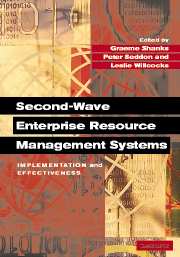Book contents
- Frontmatter
- Contents
- List of Contributors
- Introduction: ERP – The Quiet Revolution?
- Part I Implementation and Effectiveness: Overview
- Part II From Risks to Critical Success Factors
- 5 Enterprise System Implementation Risks and Controls
- 6 Risk Factors in Enterprise-wide/ERP Projects
- 7 A Framework for Understanding Success and Failure in Enterprise Resource Planning System Implementation
- 8 Critical Success Factors Revisited: A Model for ERP Project Implementation
- 9 Offsetting ERP Risk through Maintaining Standardized Application Software
- Part III From Learning to Knowledge
- Part IV Cultural Aspects of Enterprise Systems
- Part V Future Directions
- Index
- References
6 - Risk Factors in Enterprise-wide/ERP Projects
from Part II - From Risks to Critical Success Factors
Published online by Cambridge University Press: 05 February 2012
- Frontmatter
- Contents
- List of Contributors
- Introduction: ERP – The Quiet Revolution?
- Part I Implementation and Effectiveness: Overview
- Part II From Risks to Critical Success Factors
- 5 Enterprise System Implementation Risks and Controls
- 6 Risk Factors in Enterprise-wide/ERP Projects
- 7 A Framework for Understanding Success and Failure in Enterprise Resource Planning System Implementation
- 8 Critical Success Factors Revisited: A Model for ERP Project Implementation
- 9 Offsetting ERP Risk through Maintaining Standardized Application Software
- Part III From Learning to Knowledge
- Part IV Cultural Aspects of Enterprise Systems
- Part V Future Directions
- Index
- References
Summary
Risk Factors in Enterprise-wide/ERP Projects
In the past several years many organizations have initiated enterprise-wide/ ERP projects, using such packages as SAP, PeopleSoft, and Oracle. These projects often represent the single largest investment in an information systems project in the history of these companies, and in many cases the largest single investment in any corporate-wide project.
These enterprise-wide/ERP projects bring about a host of new questions, because they represent a new type of management challenge. The management approaches for these projects may be altogether different from the managerial approaches for traditional MIS projects. Some of these questions and issues are:
What are the major risk factors associated with implementing traditional MIS projects?
What are the major risk factors associated with enterprise-wide information management projects?
What are the differences? What new risk factors need to be addressed in ERP projects? What are some of the risks in ERP projects that are not factors in non-ERP projects?
Most organizations have extensive experience managing traditional MIS projects, but these new ERP projects may represent new challenges and present new risk factors that must be handled differently. This paper will provide case studies of seven organizations implementing enterprise-wide/ERP projects and will provide insight into each of these questions based upon their experiences.
- Type
- Chapter
- Information
- Second-Wave Enterprise Resource Planning SystemsImplementing for Effectiveness, pp. 157 - 179Publisher: Cambridge University PressPrint publication year: 2003
References
- 4
- Cited by

